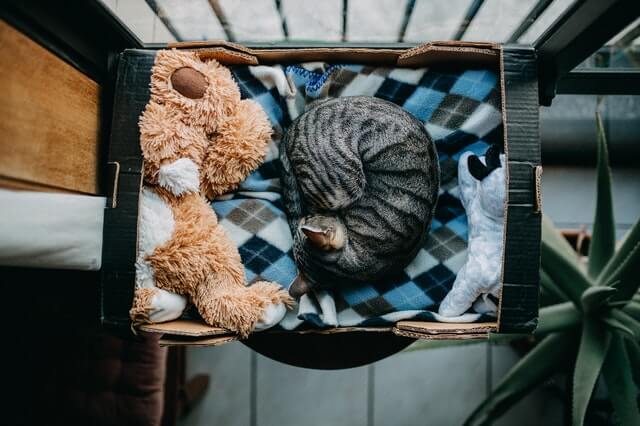Moving to a new home can be stressful for us and our cats. Whether you are upgrading, downsizing, moving to a house, apartment, or anything in between, moving can be a huge, life-altering change. Most cat owners know that even their most outgoing curious cat can be sensitive to stress. Cats can exhibit stress in many ways (which will be discussed). For your move with a cat to be as stress-free as possible, help your cat adjust as much as you can with these tips.
How to Help Your Cat Adjust to a New Home
1. Pheromones and Supplements
Before moving day, introduce your cat to calming pheromones and supplements to help reduce their stress level as the changes such as packing and moving and unpacking begin. Make sure to ask your veterinarian for their recommendations and what pheromones and supplements would be best to help your cat.
- Pheromones – Pheromones are a type of chemical communication that cats use naturally. They give cats signals to each other from various scent glands on their bodies. These signals relay information such as marking territory, identifying other cats, bonding to each other, soothing, and signals of happiness or familiarity. Pheromone products such as Feliway, use synthetic pheromones to help with calming and stress in cats. They provide those same signals that the cat is in a safe and stress-free place. These pheromones can be delivered to the cat through plug in diffusers, sprays, or wipes to be used around the cat’s environment. It is best to start using these well before the stressful event so your cat can get used to them. Continue using these during and after the move as well. Spray your cat’s travel carrier and favorite bed and use the diffusers in the new home.
- Supplements – There are various calming supplements that can help decrease your cat’s stress and anxiety. Composure Pro chews contain ingredients such as thiamine (Vitamin B1), L-Tryptophan, a Colostrum calming complex, and L-Theanine that help provide behavioral and stress support. Calming Care is a special probiotic that helps cats cope with stress and improve anxious behaviors by reducing stress hormones such as cortisol and supporting the immune system.
2. Provide a Safe Place
Before bringing your cat into your new home, walk around and make sure it is a safe environment. Ensure that there are no rodent poisons, toxic chemicals, or plants, dangerous crawl spaces, or holes where she could get stuck or lost. Because several common house plants are actually some degree of toxic to your pet, like aloe vera or peace lilies, for example, you’ll want to take extra care. 1
Once your cat is in the new home, offer a special place for your cat to call her own. Make sure it is a quiet place out of the way of all the commotion. Set up your no dust cat litter box in a quiet dark area and make sure she knows where to find her food and water. Set up a favorite cat tree by a window and put out familiar, comfortable beds and toys. Remember to keep doors and windows closed so she doesn’t escape and get lost outside in an unfamiliar place. If you notice her acting particularly anxious, she may benefit from a cat cave bed to allow her to feel safe and protected while she sleeps.
3. Familiarity

Image courtesy of Pexels
Don’t forget to bring along all your cat’s favorite belongings. By bringing her favorite blankets, beds, toys, cat trees, and other special items, you are providing your cat with items that are comforting and safe. Include items that smell like your cat or you to further give the feeling of familiarity. Consistency is key. A move is not the best time to switch diets, food and water bowls, types of litter or litterboxes, or bring new pets into the family. Make sure your cat is well-adjusted before making too many changes in her routine or surroundings.
4. Enrichment
Provide toys and activities so your cat doesn’t get bored. Make time to play with your cat to encourage exercise and spend time together.
5. Give it Time
The introduction to a new home should happen gradually and with a lot of patience. The amount of time it will take your cat to adjust to the new home can vary. Just like people, every cat has a different personality and way of adjusting to a new space and routine. Some cats will adjust quickly and readily take on their new environment, while others might be shy, scared, or reserved and may take several weeks or even months to become comfortable and at ease in a new home.
6. Pay Attention
Don’t forget to spend time with your cat and observe her habits closely to make sure she is adjusting well. Watch for changes in behavior or signs of stress, discomfort, or illness. Notice habits such as eating, drinking, and litterbox habits to make sure there are no concerning changes. As always, if you notice something abnormal, talk to your veterinarian about what to do.
How to Know if Your Cat is Stressed

Image courses of Pexels
Cats are great at hiding how they feel – especially if they are sick or stressed. You may only notice subtle changes in behavior or habits as indications your cat is feeling stressed. Other times, your cat will display major changes to indicate they are unhappy.2
Signs of stress in cats:
- Peeing outside the litter box.
- Hiding more than usual and being antisocial.
- Fighting with other cats.
- Changes in appetite or drinking.
- Overgrooming or pulling hair out.
- Changes in activity level – either more active and anxious or less active and lethargic.
- Scratching or chewing furniture or other items.
- Abnormal vocalization – meowing, yowling, growling, or hissing when they normally wouldn’t.
It can be difficult to recognize these signs of stress right away, but it is important to pay attention to both subtle and major changes in your cat. Some of the signs of stress can also indicate illness or other health issues in your cat. Talk to your veterinarian if you are at all concerned about your cat’s behavior.
Article Sources
Pet News Daily uses only high-quality sources, including peer-reviewed studies, to support the facts within our articles. Read our editorial process to learn more about how we fact-check and keep our content accurate, reliable, and trustworthy.
- Toxic and Non-Toxic Plant List – Cats. aspca.org. Accessed 4 Nov 2021.
- de Souza Machado D, Oliveira PMB, Machado JC, Ceballos MC, Sant’Anna AC. Identification of separation-related problems in domestic cats: A questionnaire survey. PLoS One. 2020;15(4):e0230999. Published 2020 Apr 15. doi:10.1371/journal.pone.0230999.

